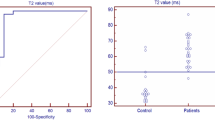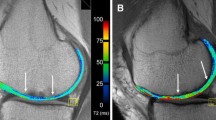Abstract
T1 rho and T2 mapping are magnetic resonance imaging (MRI) techniques to detect early degenerative changes in cartilage. Recent advancements have enabled 3D acquisition for both techniques. The objective of the present study was to examine the correlation of 3D T1 rho and 3D T2 mapping with macroscopic and histological characteristics of knee cartilage. Twenty-one patients who underwent total knee arthroplasty due to osteoarthritis with involvement of the medial compartment but with minimum involvement of the lateral compartment were enrolled. Prior to surgery, five series of MRI were acquired with a 3-T scanner. 3D T1 rho/T2 analyses were performed following determination of regions to be assessed using in-house software that incorporated three series of MRI acquisitions data (3D-MERGE, 3D-SPGR, and 3D-CUBE). During surgery, the cartilage of the lateral compartment was macroscopically assessed with the International Cartilage Research Society (ICRS) articular classification system. The extracted specimens were histologically assessed using the OARSI histology score. Three regions of interest (ROI) were assessed for each slice (two slices per knee): the central lateral femoral condyle (cLFC), the posterior portion of the lateral femoral condyle (pLFC), and the lateral tibia plateau (LTP). For each ROI, the mean T1 rho and T2 relaxation time, the ICRS grade, and the OARSI score were compared. Neither the T1 rho nor the T2 reflected the macroscopic grading. The T1 rho could discriminate between histological grades 1 and 2. However, the T2 could not. The T1 rho relaxation time was higher in the pLFC than in the cLFC even in the same grade. Compared to T2 mapping, T1 rho mapping may have an advantage in differentiating grades I and II cartilage degeneration on OARSI histological grading system.



Similar content being viewed by others
References
Madry H, Luyten FP, Facchini A (2012) Biological aspects of early osteoarthritis. Knee Surg Sports Traumatol Arthrosc 20:407–422
Mosher TJ, Walker EA, Petscavage-Thomas J, Guermazi A (2013) Osteoarthritis year 2013 in review: imaging. Osteoarthr Cartil 21:1425–1435
Nishioka H, Hirose J, Okamoto N, Okada T, Oka K, Taniwaki T, Nakamura E, Yamashita Y, Mizuta H (2015) Evaluation of the relationship between T1 and T2 values and patella cartilage degeneration in patients of the same age group. Eur J Radiol 84:463–468
Wei B, Du X, Liu J, Mao F, Zhang X, Liu S, Xu Y, Zang F, Wang L (2015) Associations between the properties of the cartilage matrix and findings from quantitative MRI in human osteoarthritic cartilage of the knee. Int J Clin Exp Pathol 8:3926–3936
Raya JG, Melkus G, Adam-Neumair S, Dietrich O, Mützel E, Reiser MF, Putz R, Kirsch T, Jakob PM, Glaser C (2016) Diffusion-tensor imaging of human articular cartilage specimens with early signs of cartilage damage. Radiology 266:831–841
Rautiainen J, Nissi MJ, Liimatainen T, Herzog W, Korhonen RK, Nieminen MT (2014) Adiabatic rotating frame relaxation of MRI reveals early cartilage degeneration in a rabbit model of anterior cruciate ligament transection. Osteoarthr Cartil 22:1444–1452
Nishioka H, Hirose J, Nakamura E, Oniki Y, Takada K, Yamashita Y (2012) T1r and T2 mapping reveal the in vivo extracellular matrix of articular cartilage. J Magn Reson Imaging 35:147–155
Takayama Y, Hatakenaka M, Tsushima H, Okazaki K, Yoshiura T, Yonezawa M, Nishikawa K, Iwamotod Y, Honda H (2015) T1 is superior to T2 mapping for the evaluation of articular cartilage denaturalization with osteoarthritis: radiological–pathological correlation after total knee arthroplasty. Eur J Radiol 85:1098–1104
Hirose J, Nishioka H, Nakamura E, Oniki Y, Yamashita Y, Mizuta H (2012) T1 and T2 mapping of the proximal tibiofibular joint in relation to aging and cartilage degeneration. Eur J Radiol 81:2776–2782
Wang L, Regatte RR (2014) Quantitative mapping of human cartilage at 3.0T: parallel changes in T2, T1r, and dGEMRIC. Acad Radiol 21:463–471
Kellgren JH, Lawrence JS (1957) Radiological assessment of osteo-arthrosis. Ann Rheum Dis 16:494–502
Souza RB, Kumar D, Calixto N, Singh J, Schooler J, Subburaj K, Li X, Link TM, Majumdar S (2014) Response of knee cartilage T1 rho and T2 relaxation times to in vivo mechanical loading in individuals with and without knee osteoarthritis. Osteoarthr Cartil 22:1367–1376
Studholme C, Hill DLG, Hawkes J (1996) Automated 3-D registration of MR and CT images of the head. Med Image Anal 1:163–175
Press WH, Teukolsky SA, Vetterling VT, Flannery BP (1994) Numerical recipes, the art of scientific computing (2nd ed). Cambridge University Press, Cambridge, pp 282–306
Carballido-Gamio J, Bauer JS, Stahl R, Lee KY, Krause S, Link TM, Majumdar S (2008) Inter-subject comparison of MRI knee cartilage thickness. Med Image Anal 12:120–135
Brittberg M, Peterson L (1998) Introduction of an articular cartilage classification. ICRS Newsletter 1:5–8
Akagi M, Mori S, Nishimura S, Nishimura A, Asano T, Hamanishi C (2005) Variability of extraarticular tibial rotation references for total knee arthroplasty. Clin Orthop Relat Res 436:172–176
Akagi M, Oh M, Nonaka T, Tsujimoto H, Asano T, Hamanishi C (2004) An anteroposterior axis of the tibia for total knee arthroplasty. Clin Orthop Relat Res 420:213–219
Pritzker KPH, Gay S, Jimenez SA, Ostergaard K, Pelletier JP, Revell PA, Salter D, van den Berg WB (2006) Osteoarthritis cartilage histopathology: grading and staging. Osteoarthr Cartil 14:13–12
Bittersohl B, Mamisch TC, Welsch GH, Stratmann J, Forst R, Swoboda B, Bautz W, von Rechenberg B, Cavallaro A (2009) Experimental model to evaluate in vivo and in vitro cartilage MR imaging by means of histological analyses. Eur J Radiol 70:561–569
McGibbon CA, Trahan CA (2003) Measurement accuracy of focal cartilage defects from MRI and correlation of MRI graded lesions with histology: a preliminary study. Osteoarthr Cartil 11:483–493
Kijowski R, Blankenbaker DG, Munoz DRA, Baer GS, Graf BK (2013) Evaluation of the articular cartilage of the knee joint: value of adding a T2 mapping sequence to a routine MR imaging protocol. Radiology 267:503–513
Palmer AJR, Brown CP, McNally EG, Price AJ, Tracey I, Jezzard P, Carr AJ, Glyn-Jones S (2013) Non-invasive imaging of cartilage in early osteoarthritis. Bone Joint J 95-B:738–746
Peterfy CG, Guermazi A, Zaim S, Tirman PF, Miaux Y, White D et al (2004) Whole-organ magnetic resonance imaging score (WORMS) of the knee in osteoarthritis. Osteoarthr Cartil 12:177–190
Wong CS, Yan CH, Gong NJ, Li T, Chane DQ, Chu YC (2013) Imaging biomarker with T1 and T2 mappings in osteoarthritis—in vivo human articular cartilage study. Eur J Radiol 82:647–650
Tsushima H, Okazaki K, Takayama Y, Hatakenaka M, Honda H, Izawa T, Nakashima Y, Yamada H, Iwamoto Y (2012) Evaluation of cartilage degradation in arthritis using T1q magnetic resonance imaging mapping. Rheumatol Int 32:2867–2875
Okazaki K, Takayama Y,·Osaki K, Matsuo Y,·Mizuchi H,·Hamai S,·Honda H,·Iwamoto Y. Subclinical cartilage degeneration in young athletes with posterior cruciate ligament injuries detected with T1ρ magnetic resonance imaging mapping. Knee Surg Sports Traumatol Arthrosc 2015; 23:3094–3100.
Nozaki T, Kaneko Y, Yua HJ, Kaneshiro K, Schwarzkopf R, Yoshioka H (2015) Comparison of T1rho imaging between spoiled gradient echo (SPGR) and balanced steady state free precession (b-FFE) sequence of knee cartilage at 3 T MRI. Eur J Radiol 84:1299–1305
Li X, Cheng J, Lin K, Saadat E, Bolbos RI, Jobke B, Ries MD, Horvai A, Link TM, Majimdar S (2011) Quantitative MRI using T1 rho and T2 in human osteoarthritis cartilage specimens: correlation with biochemical measurements and histology. Magn Reson Imaging 29:324–334
Goto H, Iwama Y, Fujii M, Aoyama N, Kubo S, Kuroda R, Ohno Y, Sugimura K (2012) A preliminary study of the T1rho values of normal knee cartilage using 3 T-MRI. Eur J Radiol 81:796–803
Li X, Pedoia V, Kumar D, Rivoire J, Wyatt C, Lansdown D, Amano K, Okazaki N, Savic D, Koff MF, Felmlee J, Williams SL, Majumdar S (2015) Cartilage T1 and T2 relaxation times: longitudinal reproducibility and variations using different coils. MR systems and sites Osteoarthritis and Cartilage 23:2214–2223
Bolbos RI, Link TM, Ma CB, Majumdar S, Li X (2009) T1rho relaxation time of the meniscus and its relationship with T1rho of adjacent cartilage in knees with acute ACL injuries at 3 T. Osteoarthr Cartil 17:12–18
Guermazi A, Alizai H, Crema MD, Trattnig S, Regatte RR, Roemer FW (2015) Compositional MRI techniques for evaluation of cartilage degeneration in osteoarthritis. Osteoarthr Cartil 23:1639–1653
van Tiel V, Kotek G, Reijman M, Bos PK, Bron EE, Klein S, Nasserinejad K, Osch G, Verhaar JAN, Krestin GP, Weinans H, Oel EH (2016) Is T1rho mapping an alternative to delayed gadolinium-enhanced MR imaging of cartilage in the assessment of sulphated glycosaminoglycan content in human osteoarthritic knees? An in vivo validation study. Radiology 2:523–531
Sandell LJ, Xing X, Franz C, Davies S, Chang LW, Patra D (2008) Exuberant expression of chemokine genes by adult human articular chondrocytes in response to IL-1b. Osteoarthr Cartil 16:1560–1571
Settle S, Vickery L, Nemirovskiy O, Vidmar T, Bendele A (2010) Cartilage degradation biomarkers predict efficacy of a novel, highly selective matrix metalloproteinase 13 inhibitor in a dog model of osteoarthritis. Arthritis & Rheum 62:3006–3015
Takahashi K, Hashimoto S, Nakamura H, Mori A, Sato A, Majima T, Takai S (2015) Medial meniscal posterior root/horn radial tears correlate with cartilage degeneration detected by T1 relaxation mapping. Eur J Radiol 85:1098–1104
Wang L, Vieira RLR, Rybaka LD, Babba JS, Changa G, Krasnokutsky S, Abramson S, Regatte R (2013) Relationship between knee alignment and T1 values of articular cartilage and menisci in patients with knee osteoarthritis. Eur J Radiol 82:1946–1952
Li X, Kuo D, Theologis A, Carballido-Gamio J, Stehling C, Link TM, Ma CB, Majumdar S (2011) Cartilage in anterior cruciate ligament–reconstructed knees: MR imaging T1 r and T2—initial experience with 1-year follow–up. Radiology 258:505–514
Thuillier DU, Souza RB, Wu S, Luke A, Li X, Feeley BT (2013) T1r imaging demonstrates early changes in the lateral patella in patients with patellofemoral pain and maltracking. Am J Sports Med 41:1813–1818
Anwander H, Melkus G, Rakhra KS, Beaulé PE (2016) T1ρ MRI detects cartilage damage in asymptomatic individuals with a cam deformity. J Orthop Res 6:1004–1009
Deneweth JM, Newman KE, Sylvia SM, McLean SG, Arruda EM (2013) Heterogeneity of Tibial plateau cartilage in response to a physiological compressive strain rate. J Orthop Res 31:370–375
Wong LB, Sah RL (2010) Mechanical asymmetry during articulation of tibial and femoral cartilages: local and overall compressive and shear deformation and properties. J Biomech 43:1689–1695
Temple MM, Bae WC, Chen MQ, Lotz M, Amiel D, Coutts RD, Sa RL (2007) Age- and site-associated biomechanical weakening of human articular cartilage of the femoral condyle. Osteoarthr Cartil 15:1042–1052
Raya JG, Melkus G, Adam-Neumair S et al (2013) Diffusion-tensor imaging of human articular cartilage specimens with early signs of cartilage damage. Radiology 266(3):831–841
Lukas VA, Fishbein KW, Lin PC, Schar E, Schneider E, Neu CP, Spencer RG, Reiter DA (2015) Classification of histologically scored human knee osteochondral plugs by quantitative analysis of magnetic resonance images at 3T. J Orthop Res 33:640–650
Kumar D, Souza RB, Subburaj K, MacLeod TD, Singh J, Calixto NE, Nardo L, Link TM, Li X, Lane NE, Majumdar S (2015) Are there sex differences in knee cartilage composition and walking mechanics in healthy and osteoarthritis populations? Clin Orthop Relat Res 473:2548–2558
Author information
Authors and Affiliations
Corresponding author
Ethics declarations
Role of the funding source
The author had no source of funding.
Disclosures
None.
Rights and permissions
About this article
Cite this article
Sasho, T., Katsuragi, J., Yamaguchi, S. et al. Associations of three-dimensional T1 rho MR mapping and three-dimensional T2 mapping with macroscopic and histologic grading as a biomarker for early articular degeneration of knee cartilage. Clin Rheumatol 36, 2109–2119 (2017). https://doi.org/10.1007/s10067-017-3645-2
Received:
Revised:
Accepted:
Published:
Issue Date:
DOI: https://doi.org/10.1007/s10067-017-3645-2




